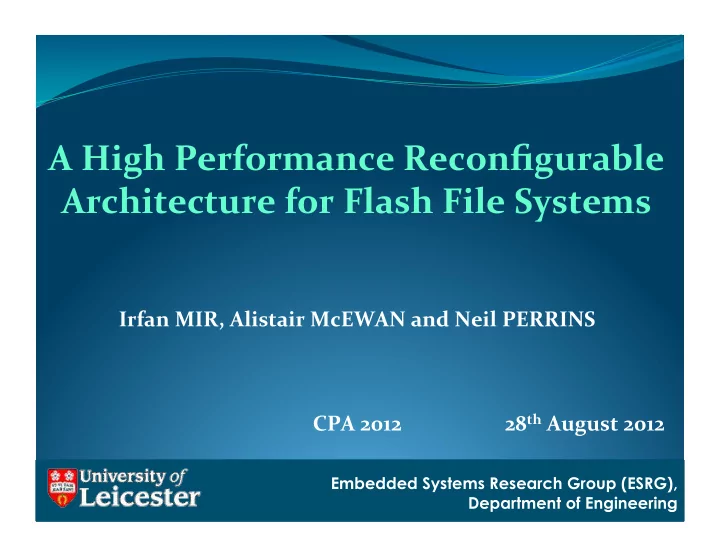

A ¡High ¡Performance ¡Reconfigurable ¡ Architecture ¡for ¡Flash ¡File ¡Systems ¡ Irfan ¡MIR, ¡Alistair ¡McEWAN ¡and ¡Neil ¡PERRINS ¡ ¡ ¡ ¡ ¡ ¡ ¡ ¡ ¡ ¡ ¡ ¡ ¡ ¡ ¡ ¡ ¡ ¡ ¡ ¡ ¡ ¡ ¡ ¡ ¡ ¡ ¡ ¡ ¡ ¡ ¡ ¡ ¡ ¡ ¡ ¡ ¡ ¡ ¡ ¡ ¡ ¡ ¡ ¡ ¡ ¡ ¡ ¡ ¡ ¡ ¡ ¡CPA ¡2012 ¡ ¡ ¡ ¡ ¡ ¡ ¡ ¡ ¡ ¡ ¡ ¡ ¡ ¡ ¡ ¡ ¡ ¡ ¡ ¡28 th ¡August ¡2012 ¡ Embedded Systems Research Group (ESRG), Department of Engineering
Quick ¡Overview ¡ Multi-tasking: Multiple programs SSD – Data Storage access SSD at the same time Flash Management Framework Performance Solution Time 2
Outline ¡ ¡Background ¡ ¡Conventional ¡Approach ¡ ¡Exploit ¡Concurrency ¡ ¡ ¡Flash ¡Management ¡Framework ¡ ¡Case ¡study ¡ ¡Performance ¡Evaluation ¡ ¡Conclusions ¡and ¡Future ¡Work ¡ 3
Background ¡ Generic ¡SSD ¡architecture ¡consists ¡of ¡a ¡number ¡of ¡chips. ¡ NAND ¡flash ¡consists ¡of ¡Erase ¡Blocks. ¡ Erase ¡Block ¡consists ¡of ¡pages. ¡ Advantages ¡over ¡magnetic ¡disk. ¡ Performance ¡degradation ¡factors: ¡ Erase-‑before-‑write ¡operation ¡ Garbage ¡collection ¡ Long ¡fixed ¡program/erase ¡times ¡ Multiple ¡chips ¡on ¡a ¡single ¡flash ¡bus ¡ Performance ¡is ¡a ¡big ¡challenge! ¡ 4
Background ¡ Performance ¡bottlenecks: ¡ Multiple ¡applications ¡ Multiple ¡access ¡requests ¡(write/read ¡/erase ¡operations). ¡ Bus ¡architecture ¡and ¡Flash ¡Translation ¡Layer ¡affect ¡ performance. ¡ FTL ¡limitation ¡factors: ¡ Usually ¡implemented ¡in ¡embedded ¡software ¡or ¡in ¡firmware. ¡ Sequential ¡in ¡nature. ¡ Limit ¡operations ¡in ¡terms ¡of ¡throughput ¡and ¡response ¡time. ¡ Commercial ¡architectures ¡ ¡are ¡NOT ¡revealed ¡in ¡public! ¡ We ¡have ¡designed ¡our ¡own ¡SSD ¡architecture! ¡ 5
Outline ¡ ¡Background ¡ ¡Conventional ¡Approach ¡ ¡Exploit ¡Concurrency ¡ ¡ ¡Flash ¡Management ¡Framework ¡ ¡Case ¡study ¡ ¡Performance ¡Evaluation ¡ ¡Conclusions ¡and ¡Future ¡Work ¡ 6
Conven5onal ¡approach ¡ Performance ¡bottlenecks: ¡ Multiple ¡operations ¡on ¡a ¡single ¡bus ¡with ¡multiple ¡chips. ¡ Flash ¡operations ¡are ¡executed ¡in ¡the ¡order ¡in ¡which ¡they ¡arrive! ¡ Operations ¡are ¡executed ¡in ¡sequential ¡manner. ¡ 7
Contents ¡ ¡Background ¡ ¡Conventional ¡Approach ¡ ¡Exploit ¡Concurrency ¡ ¡ ¡Flash ¡Management ¡Framework ¡ ¡Case ¡study ¡ ¡Performance ¡Evaluation ¡ ¡Conclusions ¡and ¡Future ¡Work ¡ 8
Exploit ¡concurrency! ¡ ¡ Reconfigurable ¡computing ¡ ¡ Parallel ¡bus ¡architecture. ¡ ¡ ¡Resulting ¡in ¡high ¡throughput ¡and ¡fast ¡response ¡time. ¡ Concurrent ¡programming ¡language ¡ ¡ Our ¡FFS ¡is ¡implemented ¡ ¡in ¡Verilog ¡HDL. ¡ ¡ ¡Thousands ¡of ¡concurrent ¡hardware ¡processes! ¡ We ¡present ¡a ¡new ¡ FPGA ¡based ¡flash ¡management ¡ framework ¡(FMF) ¡using ¡reconfigurable ¡computing, ¡ implemented ¡in ¡synthesizable ¡Verilog. ¡ ¡ 9
Contents ¡ ¡Background ¡ ¡Conventional ¡Approach ¡ ¡Exploit ¡Concurrency ¡ ¡Flash ¡Management ¡Framework ¡ ¡Case ¡study ¡ ¡Performance ¡Evaluation ¡ ¡Conclusions ¡and ¡Future ¡Work ¡ 10
Flash ¡Management ¡Framework ¡(FMF) ¡ Major ¡components: ¡ ¡ User ¡data/instruction ¡transfer ¡protocol ¡ ¡Embedded ¡flash ¡translation ¡layer ¡ ¡NAND ¡flash ¡hybrid ¡controller ¡layer ¡ 11
Flash ¡Management ¡Framework ¡(FMF) ¡ Major ¡features: ¡ Out-‑of-‑order ¡execution ¡exploiting ¡multi-‑chip ¡parallelism. ¡ Command ¡scheduling ¡on ¡ X*Y*Z ¡write/read/erase ¡requests: ¡ X ¡-‑ ¡Flash ¡buses ¡ Y ¡-‑ ¡Flash ¡chips ¡per ¡bus ¡ Z ¡ -‑ ¡Chip ¡conflicts ¡ Dynamic ¡scheduling ¡on ¡the ¡basis ¡of ¡ Erase-‑Write-‑Read ¡(EWR) ¡ command ¡sequence. ¡ Effectively ¡handle ¡chip ¡conflicts ¡and ¡data ¡dependency. ¡ Dynamic ¡chip ¡assignment ¡for ¡write ¡operations ¡using ¡auto ¡ physical ¡page ¡address ¡generator ¡mechanism. ¡ 12
FMF ¡-‑ ¡Flash ¡opera5ons ¡ Page write operation Page read operation 13
Contents ¡ ¡Background ¡ ¡Conventional ¡Approach ¡ ¡Exploit ¡Concurrency ¡ ¡ ¡Flash ¡Management ¡Framework ¡ ¡Case ¡study ¡ ¡Performance ¡Evaluation ¡ ¡Conclusions ¡and ¡Future ¡Work ¡ 14
Case ¡study ¡ ¡ ¡ Scenario ¡1: ¡ ¡ Multi ¡sector ¡write/read ¡operations ¡per ¡flash ¡bus ¡with ¡no ¡conflicts. ¡ 15
Case ¡study ¡ Scenario ¡2: ¡ Multi ¡sector ¡write/read ¡operations ¡per ¡flash ¡bus ¡with ¡chip ¡ conflicts. ¡ 16
Case ¡study ¡ Scenario ¡3: ¡ ¡ Multi ¡sector ¡write/read/erase ¡operations ¡per ¡bus ¡with ¡chip ¡ conflicts. ¡ 17
Outline ¡ ¡Background ¡ ¡Conventional ¡Approach ¡ ¡Exploit ¡Concurrency ¡ ¡Flash ¡Management ¡Framework ¡ ¡Case ¡study ¡ ¡Performance ¡Evaluation ¡ ¡Conclusions ¡and ¡Future ¡Work ¡ 18
Performance ¡evalua5on ¡ Parameters ¡for ¡experiments ¡ Page ¡and ¡sector ¡have ¡same ¡size ¡(4KB). ¡ Two ¡8-‑bit ¡buses ¡where ¡each ¡bus ¡has ¡5 ¡NAND ¡chips. ¡ Page ¡read ¡(25 ¡µsec), ¡Page ¡program ¡(550 ¡µsec) ¡and ¡Block ¡erase ¡(1.5 ¡msec). ¡ Data ¡transfer ¡time ¡of ¡a ¡flash ¡page ¡is ¡150 ¡µsec. ¡ . 19
Outline ¡ ¡Background ¡ ¡Conventional ¡Approach ¡ ¡Exploit ¡Concurrency ¡ ¡Flash ¡Management ¡Framework ¡ ¡Case ¡study ¡ ¡Performance ¡Evaluation ¡ ¡Conclusions ¡and ¡Future ¡Work ¡ 20
Conclusions ¡and ¡future ¡work ¡ Conclusions ¡ Our ¡new ¡flash ¡management ¡framework ¡(FMF) ¡is ¡a ¡viable ¡way ¡to ¡ develop ¡a ¡high-‑performance ¡NAND ¡flash-‑based ¡file ¡system. ¡ It ¡is ¡mainly ¡based ¡on ¡out-‑of-‑order ¡execution ¡technique ¡with ¡ exploitation ¡of ¡multi-‑chip ¡parallelism. ¡ Our ¡synthesizable ¡Verilog ¡implementation ¡of ¡FMF ¡can ¡be ¡mapped ¡ onto ¡any ¡FPGA ¡fabric. ¡ ¡ Compared ¡to ¡conventional ¡approach, ¡our ¡FMF ¡provides ¡a ¡high ¡ throughput ¡and ¡reduced ¡response ¡time. ¡ Future ¡work ¡ ¡ We ¡are ¡building ¡a ¡parameterized ¡test ¡bench ¡to ¡evaluate ¡our ¡FMF ¡ in ¡all ¡possible ¡scenarios ¡under ¡the ¡synthetic ¡and ¡real ¡workloads. ¡ 21
Recommend
More recommend